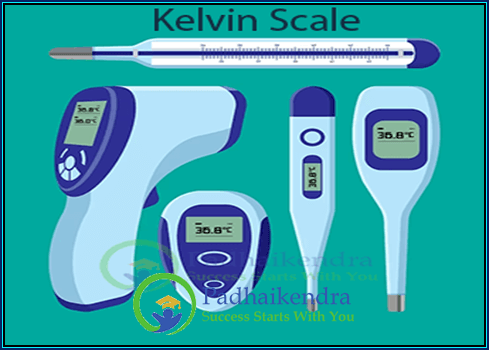Kelvin Scale Definition
The Kelvin scale of temperature is a way to measure how hot or cold something is. It is named after the Scottish physicist William Thomson, also known as Lord Kelvin. The Kelvin scale is different from the Celsius and Fahrenheit scales because it doesn’t use degrees (like °C or °F). Instead, it starts from absolute zero, the coldest possible temperature and measures temperatures using kelvin (K).
Key Points about the Kelvin Scale
Here are some key points about the Kelvin scale:
 Absolute Zero: Absolute zero is the lowest temperature possible, where all molecular motion stops. On the Kelvin scale, it is represented as 0 K. It is equal to -273.15 degrees Celsius (°C) or -459.67 degrees Fahrenheit (°F).
Absolute Zero: Absolute zero is the lowest temperature possible, where all molecular motion stops. On the Kelvin scale, it is represented as 0 K. It is equal to -273.15 degrees Celsius (°C) or -459.67 degrees Fahrenheit (°F).
Kelvin as a Unit: The unit of temperature on the Kelvin scale is called kelvin (K). It is the same size as the degree Celsius (°C) since the two scales have the same size between each degree. However, the Kelvin scale starts from absolute zero, while the Celsius scale starts from the freezing point of water.
No Negative Kelvin: Unlike the Celsius and Fahrenheit scales, the Kelvin scale does not have negative values. Since it starts from absolute zero, all temperatures on the Kelvin scale are positive numbers.
Equal Temperature Steps: On the Kelvin scale, the size of each step or degree is the same throughout the scale. This makes it useful for scientific calculations because the temperature intervals are consistent.
Absolute Hot: On the Kelvin scale, there is also a concept called absolute hot, which is the highest possible temperature. It is considered to be infinitely high and has no practical value in our everyday lives.
Applications of Kelvin scale
The Kelvin scale is commonly used in scientific fields, especially in physics and chemistry, because it is closely related to the behavior of gases and the laws of thermodynamics. It is particularly useful in calculations involving temperature changes, as it avoids negative values and simplifies mathematical operations.
The Kelvin scale is a temperature scale that starts from absolute zero, has no negative values, and uses the unit kelvin (K). It provides a consistent and absolute measurement of temperature and is widely used in scientific research and calculations.
Kelvin scale of temperature FAQs
The Kelvin scale is an absolute temperature scale commonly used in scientific and technical contexts. It is named after the Scottish physicist William Thomson, also known as Lord Kelvin. The Kelvin scale starts at absolute zero, which is the lowest possible temperature, and has no negative values.
Unlike the Celsius and Fahrenheit scales, which have arbitrary zero points, the Kelvin scale uses absolute zero as its zero point. Absolute zero, represented as 0 K, is the point at which all molecular motion theoretically ceases. The Kelvin scale has the same size increments as the Celsius scale, with one Kelvin being equivalent to one degree Celsius.
To convert a temperature in Celsius to Kelvin, simply add 273.15 to the Celsius value. The Kelvin value represents the same temperature increment as the Celsius value, but starting from absolute zero.
The Kelvin scale is used in scientific applications because it aligns with the principles of thermodynamics and allows for more precise calculations. The Kelvin scale is particularly useful when dealing with temperature differences, absolute zero, and calculations involving gas laws.
The Kelvin scale has several advantages in scientific applications. It eliminates negative temperatures, making calculations and comparisons more straightforward. It also allows for direct proportionality between temperature and other thermodynamic properties, such as pressure and volume in gas laws. Additionally, the Kelvin scale is the standard for international scientific communication.
No, temperatures on the Kelvin scale cannot be negative. Absolute zero, which is 0 Kelvin, represents the absence of molecular motion and is the lowest possible temperature. As such, temperatures on the Kelvin scale only increase from absolute zero.
The Kelvin scale is directly related to the concept of heat. Temperature, which is measured in Kelvin, is a measure of the average kinetic energy of particles in a substance. As heat is the transfer of energy from a hotter object to a cooler object, the difference in temperature between the two objects is a key factor in determining the direction and magnitude of heat transfer.
While the Kelvin scale is primarily used in scientific and technical contexts, it is occasionally used in specialized fields such as meteorology and some engineering applications. In most everyday situations, the Celsius and Fahrenheit scales are more commonly used for temperature measurements.
The Kelvin scale is used in various practical applications. It is commonly used in research laboratories, industrial processes, and engineering calculations where precise temperature control and measurement are necessary. The Kelvin scale is also used in space exploration and astronomy to measure extremely low temperatures in outer space.
Yes, the Kelvin scale is the only absolute temperature scale in use today. Other temperature scales, such as Celsius and Fahrenheit, have arbitrary zero points and do not directly represent absolute zero. The Kelvin scale provides a true zero reference point and is essential for many scientific and thermodynamic calculations.
 Absolute Zero: Absolute zero is the lowest temperature possible, where all molecular motion stops. On the Kelvin scale, it is represented as 0 K. It is equal to -273.15 degrees Celsius (°C) or -459.67 degrees Fahrenheit (°F).
Absolute Zero: Absolute zero is the lowest temperature possible, where all molecular motion stops. On the Kelvin scale, it is represented as 0 K. It is equal to -273.15 degrees Celsius (°C) or -459.67 degrees Fahrenheit (°F).




